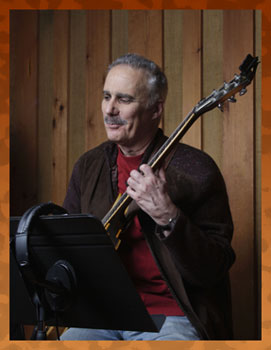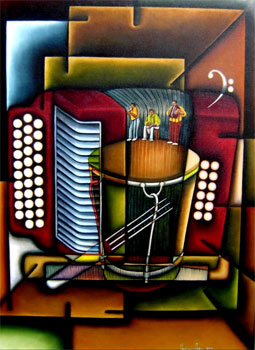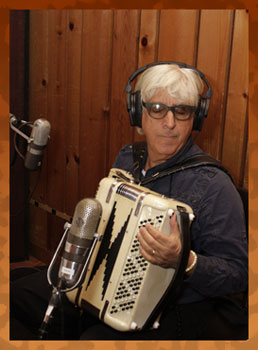

|
Soundclip:
|
| See Steve's Hand-Written Solo
Transcription |
|
Steve Khan's solo on: "Cada Gota de Mar"(Steve Khan-Mariana Ingold) For many years now, I have enjoyed the genre of music, Vallenato, that comes from the north of Colombia. After being first exposed to it, I tried to listen to more and more of it, and just became fascinated by it on so many levels. As I have continued to explore Latin music, and re-imagine just what the role of the guitar could be in this great music, or perhaps more specifically in Latin Jazz, I began to wonder if it could be possible to do some kind of fundamentally instrumental piece of music that embraced some of the elements that were so wonderful to me within Vallenato: the rhythms of cumbia, the sound of the accordion, and the general spirit of the music. In the end, I could not see doing this without the presence of a voice, and there being an actual song with lyrics. So, from that humble point-of-departure, I sought to put together a piece of music that could do all these things. My first thought was that Manolo Badrena and I could write a song together which he could sing, and everything would be great. Inspired by, in part, the following songs and artists:  "La Cachucha Bacana" by Alejo Durán; "Bonita" by Diomedes Díaz; "Matilde Lina" by Carlos Vives; and "La Gringa" by Silvestre Dangond, I attempted to formulate the structure of a Vallenato-style song into a very rough sounding demo. Unfortunately, I guess the concept and my demo were just not inspiring enough for Manolo, and we never really got any further than some e-mails and some phone calls. "La Cachucha Bacana" by Alejo Durán; "Bonita" by Diomedes Díaz; "Matilde Lina" by Carlos Vives; and "La Gringa" by Silvestre Dangond, I attempted to formulate the structure of a Vallenato-style song into a very rough sounding demo. Unfortunately, I guess the concept and my demo were just not inspiring enough for Manolo, and we never really got any further than some e-mails and some phone calls.What eventually became "Cada Gota de Mar" was the product of yet another wondrous miracle of the Internet Age, as I was "introduced" to singer/songwriter/instrumentalist, Mariana Ingold from Uruguay. When I first heard her fantastic song, "Vuelo" [co-composed with her longtime novio, Kit Walker], which was sent to me by another Uruguayo, guitarist Leonardo Amuedo, I sensed that she was a person who could possibly bring all these elements to life. And so, communicating via e-mails, Skype, and other contemporary tools, the process of co-writing a song began in April of 2013. As for the all important role of the accordion, who else, in New York City, could have filled that need but the always inventive Gil Goldstein. He plays so great throughout this performance, and adds so much personality to this event. "SUBTEXT" became the vehicle on which I could present this song to everyone, in hopes that you might enjoy it, and perhaps even feel compelled to explore the real Vallenato artists and their music. Harmonically speaking, most of the great songs in this genre are relatively simple, going back and forth from I-V-V-I with an occasional vi chord appearing every so often. If you have already heard "Cada Gota de Mar" in its entirety, you would know that during the Intro [I], the Soli [I2], and the principal vocal sections [A], those are really the kinds of chords that you hear. However, I did manage to insert, hopefully with some degree of subtlety, some more sophisticated colors on some of the Eb major chords, and the Bb7 chords as well. The bridge [B], well, here I couldn't resist going James Brown on everyone, and taking it to the IV7 chord, Ab7. For the guitar solo section, I wanted it to be a complete contrast to anything and everything one had heard during the first parts of the song. So, with F-natural as my pivot tone from Bb7, I used the little pick-up and break figure to move into an area of D7(#9). Here, a very understated orchestration enters, which frees me to just concentrate on single-note lines. The chord changes, using the top note, F-natural as a window, all come from that note as we will discuss. Only one chord change, the Gmaj7(9), resolves up a 1/2-step to F#. But that's the only one. The main thing with this solo section is to provide a sense of mystery, and great contrast to the "song" itself. The solo format is laid-out so that you play 8 bars of D7(#9), and then 4 bars of the chord that follows. In all, one could view the solo format as having 6 segments, and that's how I will address each section below. Segment 1 begins with a direct quote from the vocal melody in the first 4 bars, but because the sonorities of D7#9 and Eb major are so different, you might not even recognize that this is what I was doing. Generally speaking, if the left-hand, in the keyboard, is playing, spelling up: F#-C-F, your improvising options are pretty wide open. In terms of scales, the D altered dominant[D, Eb, F, F#, Ab, Bb, C] is as good as any. In bar 5, if you spelled a chord upwards from A(5th)-C(7th)-F(#9)-Ab(b5), and if you inverted that, this is the line that I play. Having the A-natural in there, the 5th of D7, would suggest that the line itself could have been derived from the D 1/2-tone/whole tone diminished scale[D, Eb, F, F#, Ab, A, B, C]. When you view that scale, knowing that you have 4 triads that are both major and minor in this cycle, you can see where F minor and F major can both function. Bars 6-7, with some chromaticism, are right out of the altered dominant scale. But I have always liked the the line construction where you have the 3rd(F#) followed by the blue note(F-natural), and then the root(D). The first chord of contrast to pivot off of the F-natural is Ebmaj7(9). Over this chord, I am fundamentally playing G minor pentatonic[G, Bb, C, D, F] with some chromaticism. The beauty of applying these minor pentatonics to major 7th chords is that you are using a language that is so close to the blues language that, in a sophisticated way, you can make a very vanilla sounding chord have a lot more soul to it. We begin Segment 2 with intervals that come right out of the last phrase of the prior segment with the emphasis on a 4th, C up to F. Bar 2 of the segment takes that interval up a minor 3rd, but adds in a C-natural, so you have Eb-C-Ab. In bars 3-5, the line is derived from the Bb dominant 7th pentatonic[Bb(#5), C, D, F(#9), Ab(b5)], which gives you 3 of the alterations, a good thing if you hear those sounds naturally.  The line in bars 6-8 begins with a bent note, but is really presenting notes from the F minor pentatonic[F(#9), Ab(b5), Bb(#5), C, Eb(b9)], and this pentatonic, over D7(#9), offers all of the altered tones. If played with feeling over such a chord, this should sound perfectly natural. From here, bar 9-12 is also all directly derived from the F minor pentatonic[F, Ab, Bb(6th), C(maj7), Eb(9th)], but over Dbmaj7, this scale produces 3 of the beautiful color tones. So when you play from this linear perspective, you can't go wrong, and again, there can be a naturally bluesy feeling to whatever you play - if done the right way! The line in bars 6-8 begins with a bent note, but is really presenting notes from the F minor pentatonic[F(#9), Ab(b5), Bb(#5), C, Eb(b9)], and this pentatonic, over D7(#9), offers all of the altered tones. If played with feeling over such a chord, this should sound perfectly natural. From here, bar 9-12 is also all directly derived from the F minor pentatonic[F, Ab, Bb(6th), C(maj7), Eb(9th)], but over Dbmaj7, this scale produces 3 of the beautiful color tones. So when you play from this linear perspective, you can't go wrong, and again, there can be a naturally bluesy feeling to whatever you play - if done the right way!Segment 3 commences with a high C-natural bent up to and played with vibrato before again outlining elements from the Bb dominant 7th pentatonic. Bar 5 accentuates a line configuration that spells out an Ab triad before coming to rest on F-natural, which by now should feel very much like the blue note that it is. One could view the line in bars 6-7 in a couple of different ways, but I like to see it as playing "the blues" while using C minor pentatonic[C, Eb(b9), F(#9), G, Bb(#5)] over the D7(#9) chord. If you choose to use this option, the only note that you have to be careful with is G(sus4), and you'll notice that the phrase on beat 1 of bar 6 has a Gb. Again, the idea is to maintain a bluesy feeling, even when using notes that to many might sound a bit out there. To me, they are not that at all. Our contrasting chord in this segment is one of the natural resolutions for any D7(alt.), and that's to go to Gmaj7. I like the pull-off triplet into the 1st bar as a common ornament in Jazz phrasing. Bars 9-10, even with a G-natural thrown-in as a consonant upper neighbor, is still right out of B minor pentatonic[B, D, E, F#, A]. By now, you should have noticed that over each of the major 7th chords, I am simply applying the minor pentatonic built from the 3rd of the chord. In bar 11, I put to use a line by using a B major triad[B-D#(#5)-F#] over Gmaj7, and the inclusion of the #5(D#) gives the line a bit of angular tension that must eventually find it way to touch upon E-natural or D-natural. You will find both of those notes in bar 12. Give this a try sometime, and see how it sounds to you! As we return to D7(#9) for Segment 4, after a breath, the opening line from bars 1-3 operates between Bb dominant 7th pentatonic and F minor pentatonic, and, as it was in Segment 2, the interval of a 4th between C-F and up a minor 3rd to Eb to Ab becomes a key motif. Entering bar 5, the line goes up a Bb triad, but ends-up being focused around F minor pentatonic again. To arrive at the harmonic area of contrast, the D7(#9) resolves to its other natural conclusion and we arrive at Gm7. Here the line functions somewhere between G Dorian[G, A, Bb, C, D, E, F] and D minor pentatonic[D, F, G, A, C]. Beginning on beat 3 of bar 8, pay attention to the usage of the descending triplet slur that leads us gracefully into the area of Gm7. Bars 11-12 features a line derived from A minor pentatonic[A(9th), C(4th), D, E(6th), G] that offers some great color tones for variety. In Segment 5, from a purely guitar perspective, begins with a line created via string-skipping between the high E-string and G-string. Still, I view the note selection as being from Bb dominant 7th pentatonic. Depending on your visual relationship to the instrument, the line in bars 3-4 could be just as easily viewed from the perspective of Eb melodic minor[Eb, F, Gb, Ab, Bb, C, D].  If you notice, the notes are exactly the same as those contained in the D altered dominant scale, but, in my view, the opening configuration Ab-G-Gb-Bb seems to relate more to Eb minor than D7 altered. In bar 8, we have another descending transition line with the same legato pull-off triplet, beginning a line that is realized from the imagined V7 chord of Bbm7, and that would be the F altered dominant scale[F, Gb, Ab, A, B, C#, Eb]. The line resolves to an F-natural(5th) on the downbeat, and what follows in bars 9-10 is from Bb minor pentatonic[Bb, Db, Eb, F, Ab]. I have to point out that, one of my favorite moments in the performance is when Gil Goldstein, on the accordion, plays a beautiful ascending line in 3rds after the Bbm7 chord arrives. It is just perfectly placed, and shows the great maturity of a wonderful accompanist. The art of such things is all to often under-appreciated, but never by me! The guitar then transitions to an ascending line for bars 11-12 that is from F minor pentatonic[F, Ab(7th), Bb, C(9th), Eb(4th)], which again provides some nice color tones. If you notice, the notes are exactly the same as those contained in the D altered dominant scale, but, in my view, the opening configuration Ab-G-Gb-Bb seems to relate more to Eb minor than D7 altered. In bar 8, we have another descending transition line with the same legato pull-off triplet, beginning a line that is realized from the imagined V7 chord of Bbm7, and that would be the F altered dominant scale[F, Gb, Ab, A, B, C#, Eb]. The line resolves to an F-natural(5th) on the downbeat, and what follows in bars 9-10 is from Bb minor pentatonic[Bb, Db, Eb, F, Ab]. I have to point out that, one of my favorite moments in the performance is when Gil Goldstein, on the accordion, plays a beautiful ascending line in 3rds after the Bbm7 chord arrives. It is just perfectly placed, and shows the great maturity of a wonderful accompanist. The art of such things is all to often under-appreciated, but never by me! The guitar then transitions to an ascending line for bars 11-12 that is from F minor pentatonic[F, Ab(7th), Bb, C(9th), Eb(4th)], which again provides some nice color tones.We have now arrived at [Segment 6], the final section for the guitar solo. The opening line in bars 1-2, I see as putting to use sounds from the D altered dominant scale, though, in viewing the neck of the guitar, it might appear to some that the opening of the line is in the area of Eb minor, around the 11th fret. In bars 3-4, the line offers a long stretch on your high E-string from the Eb up to Ab, as the remainder of the line is from the Ab dominant 7th pentatonic[Ab(b5), Bb(#5), C, Eb(b9), Gb]. And just as it is for Bb dominant 7th pentatonic, the Ab version offers 3 of the possible 4 altered tones. The conclusion of the lines in bars 7-8 is right out of the F minor pentatonic. As we arrived at the final contrasting harmonic area of Gbmaj7, the lines are right from the Bb minor pentatonic[Bb, Db, Eb, F, Ab]. One last time, this is, yet again, the minor pentatonic built from the 3rd of the major 7th chord. The closing line in bars 11-12 makes a very nice transition to the line that doubles Mariana Ingold's vocal transition in [A4], which is going to take us right to a vocal reprise of [B2]. You might want to pay attention to the little transition line that you see in bar 4 of [A4] over the A7(9b5), which, as we are headed to Ab7, is the b5 substitute for Eb7. The little line beginning on beat 2 features a bit of a whole-tone idea that, often times, can sound good over a 7(9b5) type of sonority. I can't express to you all just how exceptionally grateful I am, and how very fortunate I felt, to have had the rhythmic guidance of Marc Quiñones, Bobby Allende, and bassist Rubén Rodríguez. They knew exactly what to do, and when and where, and they give the piece a very funky kind of New York Puertorriqueño sense of swing. The tune grooves hard from beginning to end. When you add in the immense sound of Dennis Chambers, things can only get better. Over the course of the whole song, I had asked Dennis if he could integrate a huge half-time backbeat as part of his approach. This is something that I associate with Carlos Vives, who has become an international star by combining the folkloric elements of Vallenato with Rock rhythms and attitudes. It became an irresistible combination for fans on both sides of the music! When there are incongruous elements to this Cumbia/Vallenato experiment, like two Judios: me and Gil, some strange chords, a vocal and lyrics by someone from Uruguay,  you have quite a cocktail of elements that might make any Colombian look cross-eyed at the whole thing. But, my most sincere hope is that, at the very least, my dear friends in Colombia will know or sense that it was all done with great love, care and respect for their music. Absolute authenticity was never a remote thought of mine! you have quite a cocktail of elements that might make any Colombian look cross-eyed at the whole thing. But, my most sincere hope is that, at the very least, my dear friends in Colombia will know or sense that it was all done with great love, care and respect for their music. Absolute authenticity was never a remote thought of mine!Where one places a tune that is the anomaly of the album can be most difficult. "María Mulambo" presented a similar problem for "PARTING SHOT" and eventually it landed at Trk. [5], which felt like the right place for such a wacky conglomerate of musical influences and styles. As I had written in a prior analysis for the opening track on "SUBTEXT," "Bird Food," I knew what the sequence of the album was going to be before we had recorded a note. That was only because I had excellent demos to listen to before we had actually played anything. And so, after great thought, "Cada Gota de Mar" just seemed to fall comfortably into the Trk. [7] slot. It appears after the ballad/bolero, "Never Let Me Go" and just before "Hackensack." So, it provides an element of great contrast between two pieces that obviously have a solid place within this collection of music. I would also want to spend a moment to express my gratitude for the immense contributions of Mariana Ingold, whose immense talents brought this rather strange little piece of music to its final form. Her melodies, which supported her lyrics, were essential elements to this end. But to have contributed such a fantastic vocal performance, that included all her own harmonies and multiple voices during the [B2] sections, and various interludes and transitions as well, was more than I could have ever hoped for. Though the chant, letter [E], in the Fade, was totally of my own invention, Mariana's vocal talents made all the complex harmonies come to life. As one who greatly appreciates the execution of such vocal harmonies, I just wanted to say how much I respect what Mariana was able to do with what I sent her. It is especially tough when I can't be there with her to "produce" the vocals as I hear them, but, she intuitively heard it the right way. After the fact, we hardly changed anything! Cada gota de mar Cada gota de mar Tiene, tiene Tiene el sabor del mar [A2] Y cada momento El sabor, el sabor de la eternidad (Ebmaj7) Y cada momento El sabor, el sabor de la eternidad (Cm7) [A3] [Instrumental 2 bars] Y yo casi me lo pierdo [Instrumental 2 bars] Por tomarme tan en serio [B] Cada encuentro es para el gozo Sin temor a que termine Cada día es más hermoso Ya no hay principio, ni fines Ni fines  Usually, after we have recorded a tune, everyone has the time to repair something, if there is the need. Once that's done, usually Marc will then overdub whatever hand percussion is necessary for that tune. In order to make the 'scraper' sounds that are a vital part of Vallenato, I was expecting Marc to break out his güira, as pictured to the left. In New York, Miami and the Caribbean, the güira is often associated with merengue, but, of all things, Marc looked at me, and said something like: "Damn, I forgot it!!!" I should mention that no one that I know of in New York would actually have, and use a guacharaca, the authentic little ridged stick used in the northern region of Colombia. Well, lucky and very crazy me, I actually have a güira at home, as part of all the Latin percussion instruments that I had collected before, during, and after my years with the Caribbean Jazz Project. The question became, "How on earth was I going to be able to run home, run upstairs, pick-up the güira, and then get back to studio without losing too much precious and expensive time. Thank goodness, Bobby Allende, whose car was parked outside of Avatar, was ready and willing to drive me home to get it. And so, we did it. It's so funny when I wonder just how many Jewish guitarists would have a güira laying around the house? My guess is, not too many!!! Of course, Marc supplied his usual percussive magic, and the tune was that much closer to feeling complete. As is always the case, in a 1,000 different ways, I am so grateful and appreciative for everything that Marc and Bobby did for this recording. Personally and musically, they were just stupendous!!! Usually, after we have recorded a tune, everyone has the time to repair something, if there is the need. Once that's done, usually Marc will then overdub whatever hand percussion is necessary for that tune. In order to make the 'scraper' sounds that are a vital part of Vallenato, I was expecting Marc to break out his güira, as pictured to the left. In New York, Miami and the Caribbean, the güira is often associated with merengue, but, of all things, Marc looked at me, and said something like: "Damn, I forgot it!!!" I should mention that no one that I know of in New York would actually have, and use a guacharaca, the authentic little ridged stick used in the northern region of Colombia. Well, lucky and very crazy me, I actually have a güira at home, as part of all the Latin percussion instruments that I had collected before, during, and after my years with the Caribbean Jazz Project. The question became, "How on earth was I going to be able to run home, run upstairs, pick-up the güira, and then get back to studio without losing too much precious and expensive time. Thank goodness, Bobby Allende, whose car was parked outside of Avatar, was ready and willing to drive me home to get it. And so, we did it. It's so funny when I wonder just how many Jewish guitarists would have a güira laying around the house? My guess is, not too many!!! Of course, Marc supplied his usual percussive magic, and the tune was that much closer to feeling complete. As is always the case, in a 1,000 different ways, I am so grateful and appreciative for everything that Marc and Bobby did for this recording. Personally and musically, they were just stupendous!!!As my dear friend, saxophonist/composer/producer, Ezequiel Serrano [a proud Colombian, who has lived in Venezuela for many, many years] wrote to me after having heard "Cada Gota de Mar" for the first time: ....pero este ...es 'único'.... je je je.... no se parece a nada que haya oído antes....je je je.....es en serio. Es muy divertido!" As we say "Goodbye!" to 2014, we are hoping that everyone has a very MERRY CHRISTMAS and a ¡FELIZ NAVIDAD! And, of course, soon it will be time to say, yet again, HAPPY NEW YEAR!!! Y por supuesto, les deseamos un muy ¡FELIZ AÑO NUEVO! Wishing you all good health, happiness, and please, maybe in 2015 we can achieve PEACE everywhere!!!
[Photos: Steve and Gil Goldstein @ Avatar Studios
by Richard Laird] |